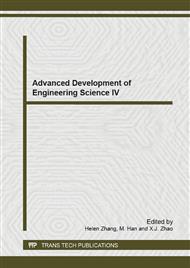[1]
G. Croiset, M. J. M. A. Nijsen, P. J.G.H. Kamphuis: Role of corticotrophin-releasing factor, vasopressin and the autonomic nervous system in learning and memory, European Journal of Pharmacology, Vol. 405(2000), pp.225-234.
DOI: 10.1016/s0014-2999(00)00556-2
Google Scholar
[2]
G. Drolet, E. C. Dumont, I. Gosselin, R. Kinkead, S. Laforest, J. F. Trottier: Role of endogenous opioid system in the regulation of the stress response, Prog. Neuro-Psychopharmacol & Biol. Psychiat., Vol. 25(2001), pp.729-741.
DOI: 10.1016/s0278-5846(01)00161-0
Google Scholar
[3]
A. Vander: Human Physiology, WCB Mcgraw-Hill(1998).
Google Scholar
[4]
K. Losstus, M. Eriksen, L. Walloe: Fluctuations in blood flow to acral skin in humans:connection with heart rate and blood pressure variability, Journal of Physiology, vol. 460(1993), pp.641-655.
DOI: 10.1113/jphysiol.1993.sp019491
Google Scholar
[5]
V. Shusterman, K. P. Anderson, O. Barnea: Spontaneous skin temperature oscillations in normail human subjects, American Physiological Society, vol. 273(1997), pp.1173-1181.
Google Scholar
[6]
M. Nitzan, A. Babchenko, B. Khanokh: Very low frequency variability in arterial blood pressure and blood volume pulse, Medical & Biological Engineering & Computing, vol. 37(1999), pp.54-58.
DOI: 10.1007/bf02513266
Google Scholar
[7]
M. Nitzan, A. Babchenko, D. Shemesh, J. Alberton: Influence of thoracic sympathectomy on cardiac induced oscillations in tissue blood volume, Medical & Biological Engineering & Computing, vol. 39(2001), pp.579-583.
DOI: 10.1007/bf02345149
Google Scholar
[8]
Marquette Electronics: Heart Rate Variability Physician's Guide, West Tower Avenue Milwaukee(1992).
Google Scholar
[9]
J. P. Saul: Beat-to-beat variations of heart rate reflect modulation of cardiac autonomic outflow, News Physiol. Sci., Vol. 5(1990), pp.32-37.
DOI: 10.1152/physiologyonline.1990.5.1.32
Google Scholar
[10]
Rong-Guan Yeh et al.: Parameter Investigation of Detrended Fluctuation Analysis for Short-term Human Heart Rate Variability, Journal of Medical and Biological Engineering, 30(5) (2010), pp.277-282.
Google Scholar
[11]
Akselrod, S., Gordon, D., Ubel, F. A., Shannon, D. C., Berger, A. C. and Cohen, R. J.: Power spectrum analysis of heart rate fluctuation: a quantitative probe of beat-to-beat cardiovascular control, Science 213(1981), 220-222.
DOI: 10.1126/science.6166045
Google Scholar
[12]
Kamath MV, Fallen el.: Power spectral analysis of heart rate variability, A noninvasive signature of cardiac autonomic function, Crit Rev Biomed Eng. (1993) ; 21: 245-311.
Google Scholar
[13]
Malliani A, Pagani M, Lombardi F, Cerutti S.: Cardiovascular neural regulation explored in the frequency domain. Circulation, 84(1991), pp.482-492.
DOI: 10.1161/01.cir.84.2.482
Google Scholar


